Menus
- Larger three-cylinder, high-quality equipment
- Equipment and handling
- engine and gears
- landing gear
- Brakes
- Processing, consumption, costs
- MOTORRAD conclusion on the Triumph Street Triple RS
- Download PDF
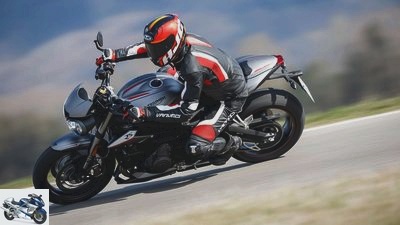
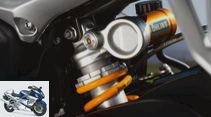
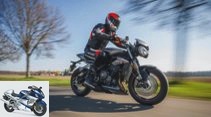
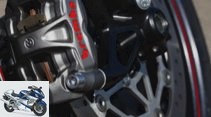
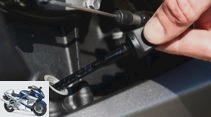
21st photos
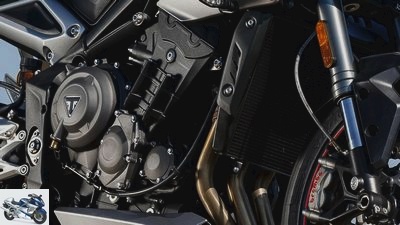
Artist
1/21
The 765 doesn’t have to fear any competition when it comes to sprinting. The three-cylinder cracks like hell at the top. The short overall ratio combined with the low weight ensures that the pulling power is also appropriate. The throttle response is excellent, the gearbox shifts well, but the clutch pressure point should be noticeably more defined. Otherwise, the smooth-running triplet pleases.
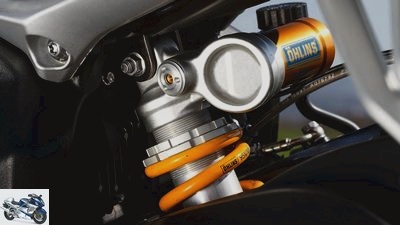
Artist
2/21
The chassis of the Triumph Street Triple RS is agile and blessed with impeccable stability. In connection with the high steering precision, this makes it an excellent corner robber. The coordination of the spring elements is accordingly clearly on the tight side, but at least leaves room for some residual comfort. The lean angle can hardly be explored on public roads, and if a passenger should ever get lost on the tight seat bun, the chassis can easily handle the load.
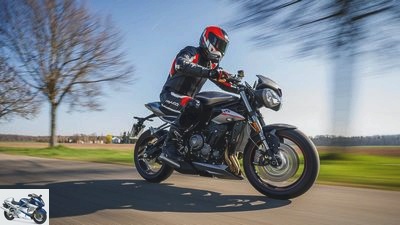
Artist
3/21
The Street Triple is a sporty type. And for this, the sitting position fits perfectly. Not too racing, but sporty and active. Arouses the need for sport without slipping into the aggressive. A pillion passenger is tolerated at best. Range, light and consideration are fine. The payload just about as well. The RS collects plus points during processing. But what you can expect given the confident price.
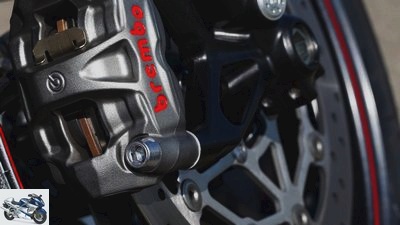
Artist
4/21
As far as braking effect and controllability are concerned, you really can’t complain about the Triumph Street Triple RS. Nevertheless, an experienced hand is an advantage when braking hard. With a pillion passenger, the RS brakes more stable. Handlebar slap and erection moment are not an issue.

Artist
5/21
Thanks to its low consumption and moderate inspection costs, the RS is not too heavy on your pocket. The extended warranty also earns points.

Artist
6/21
The point yield is considerable. But that’s the price too. But the bottom line is still a top grade.
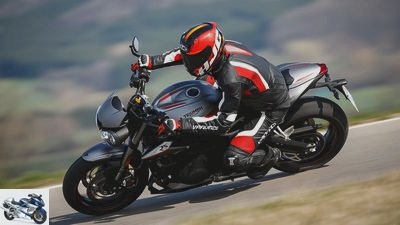
7/21
With more displacement, more power, more versions, the Triumph Street Triple (here as RS) should continue to rule over the mid-range Nakeds.
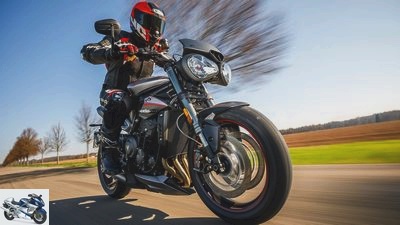
8/21
The handlebars, which are not too wide and not too deep, ask the upper body slightly forward. The pegs add some sporty flavor to the leg posture. Everything active, but not cramped.
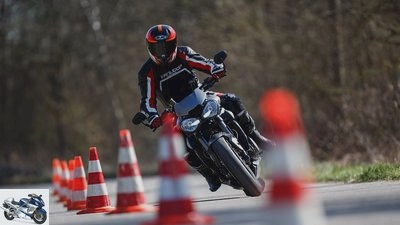
9/21
The firm, authentic seat cushion offers clear feedback and enough space to slide back and forth.
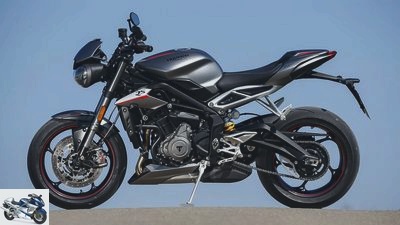
10/21
Externally, the Triumph Street Triple RS with 765 cm³ has not moved far from its predecessor.
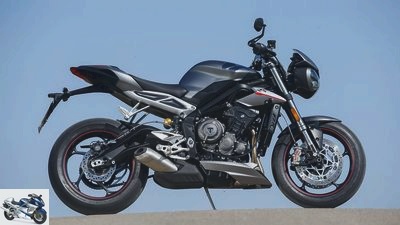
11/21
The exhaust was lighter and more compact. The oval eyes look good on her.
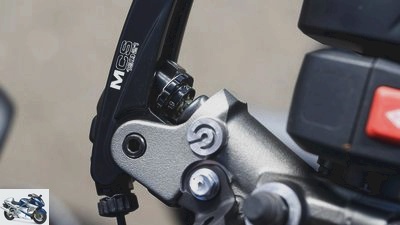
12/21
On the Brembo brake pump MCS-19.21, the linkage of the brake piston can be changed to adjust the pressure point.
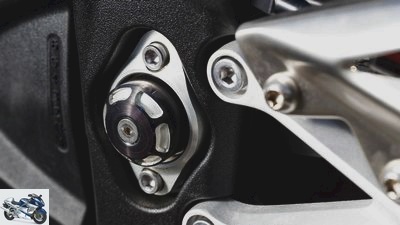
13/21
For more driving stability, the technicians raised the pivot point by four millimeters. Otherwise the chassis remained unchanged compared to the previous model.
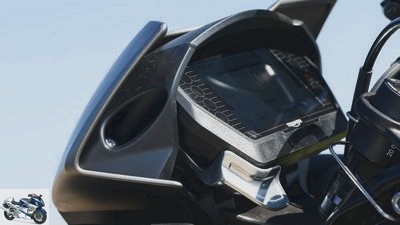
14/21
The TFT display is for better readability …

15/21
… adjustable in incline.
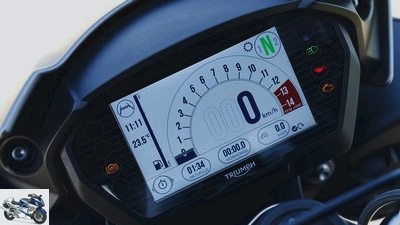
16/21
There are three display variants available.
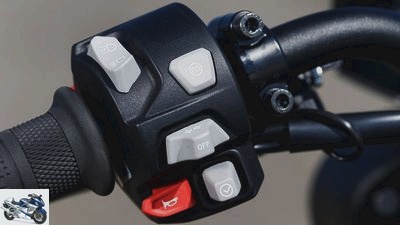
17/21
Four riding modes (Road, Rain, Sport, Track) are selectable, combining two ABS, three throttle and four traction control setups. A personal mode with individual coordination can be put together for this purpose.
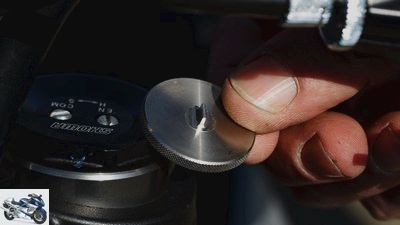
18/21
Workmanship and add-on parts please, even little things have been thought of. As the fork’s damper screws are covered by the handlebar, a special tool is included. This is fiddly to use and easily slips out of the holder under the pillion seat – but at least.
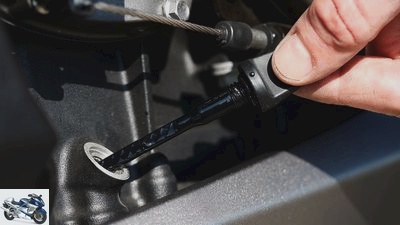
19/21
Even if the crankcase is basically ten years old, an oil sight glass instead of the dipstick wouldn’t be an exaggerated modernist luxury.
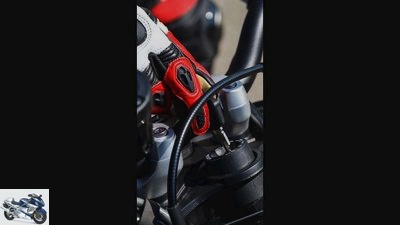
20/21
Fiddly: The ignition key has to be threaded through between the upper handlebar clamp and the rather stiff clutch cable.
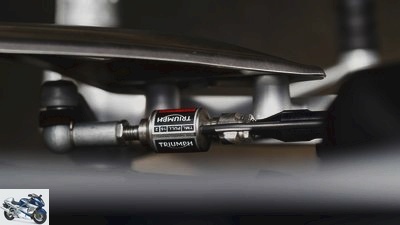
21/21
The automatic gearshift fitted as standard on the RS (and R) does its job properly, but only works when upshifting.
Triumph Street Triple RS in the top test
Larger three-cylinder, high-quality equipment
The Triumph Street Triple is receiving a major overhaul after 10 years of construction. More displacement, more power, more versions. So their three-cylinder should continue to rule over the middle class Nakeds. The top model Triumph Street Triple RS competes in the MOTORRAD top test.
The triumph S.treet Triple has the ingenious idea of shaking up the middle class with a classy three-cylinder in the top chassis. That was ten years ago. However, standing still means going backwards, the middle class is slowly positioning itself around 900 cm³, and the competition has not slept, but has passed the Triumph Street Triple. More power and a bigger engine had become necessary. The Triumph Street Triple now has both. From 675 cm³ to 765, from 106 PS to RS 123 in the top version. We feel this in the MOTORRAD-Top-Tst. The 675 was already a top-class joke grenade. The whole thing with more pressure and the finest components? Will be a festival!
Buy complete article
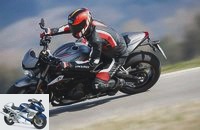
Triumph Street Triple RS in the top test
Larger three-cylinder, high-quality equipment
Sitting position
The Triumph Street Triple RS offers its driver an ingenious arrangement: the handlebars, which are neither too wide nor too deep, ask the upper body slightly forward. The pegs add some sporty flavor to the leg posture. Everything active, but not cramped. In addition, a firm, authentic seat cushion offers clear feedback and enough space to slide back and forth. The mirrors at the ends of the handlebars are not particularly suitable for rummaging through the city, but they offer sufficient rearward visibility.
Equipment and handling
At the first push of a button, the Triumph Street Triple RS begins its top test work with a full babble. The clutch is easy, the first gear engages cleanly, but the clutch point is a bit pasty. When starting up, keep the speed above 2000 rpm so that the treble does not fall into a small hole.
The Triumph Street Triple RS runs smoothly from the lowest revs. If anything, it affords minimal vibrations in the first half of the speed. The engine purrs through the rev range like a kitten. It’s wonderful how it changes its pitch depending on the speed and load, grumbles sleepily, babbles lively and is always beautifully present in the ear. Even the first few kilometers at a low speed are acoustically enjoyable.
The brilliant TFT display of the Triumph Street Triple RS allows you to choose between three display forms and the incline can be adjusted. This means that the driver has everything in view, regardless of body size and position of the sun. Setting the menus and calling up information, so far not exactly a strength of the Triumphs, is now done quickly and intuitively by a joystick on the left switch unit after a short familiarization.
The Triumph Street Triple RS offers four riding modes (Road, Rain, Sport, Track) that combine two ABS, three throttle and four traction control setups in different ways. A personal mode with individual coordination can be put together for this purpose.
engine and gears
The 765 three-cylinder of the Triumph Street Triple RS accelerates wonderfully gently under all circumstances. He only knows load changes when closing the gas; he opens the throttle valve smoothly at all times. This makes precise gas application at the apex of the curve child’s play. So you can concentrate fully on the choice of lines when cornering and on giving the three-cylinder spurs.
Then he adds acoustically a shovel, roars pithily from the airbox when the throttle valve is wide open. Evenly, like a rubber band, he pushes forward. Not overpowering in the middle, but overall with a respectable passage on par with the 900 competition.
From 9000 rpm there is a fire in the hut. The throaty tone increases in sharpness, and the tachometer snaps like pricked towards the red area. As meek as it acts down below, the three of a kind goes to work at the top. And for really jagged manogers, simply shift down and enjoy the brilliant revving and the greedy sound.
You don’t have to worry about a wildly rising front wheel thanks to the front-heavy weight distribution of the Triumph Street Triple RS. which benefits the acceleration. Thanks to a properly functioning automatic gearshift, the next gear is quickly put up; When loading properly, it lines up neatly aisle after aisle. You don’t even need the standard Quickshifter: Even when shifting with the clutch, the gears slip precisely and even more smoothly at low speeds.
The higher performance that sets the Triumph Street Triple RS apart from its sisters S and R does not only come from the electronics: sharper camshafts, short intake stacks, special manifolds without interference tubes and all this, flanked by adapted ignition / injection mappings, give the RS its 123 PS. On the dyno she even let a whopping 128 hp gallop up.
landing gear
Artist
Triumph Street Triple RS shock absorber
It almost goes without saying that with so much sporting ambition, the chassis does not spoil itself. The Triumph Street Triple RS cuts an excellent figure in the fiery twist. She stabs precisely in the corners, aiming for a line and hitting it is child’s play. It willingly allows itself to be guided down into the deepest inclines on the wide handlebars. Erection moment? Negligible.
The tuning of the suspension elements shows in the test on the sporty, taut side, but has retained some residual comfort – the fork more than the shock absorber. Short, hard edges also penetrate the driver’s rear as such.
The reward is enormous cornering stability. The Triumph Street Triple RS also stubbornly sticks to its line when exiting a curve, even if the driver pulls the cable tight. To do this, the technicians raised the pivot point by four millimeters. Otherwise the chassis remained unchanged. What is new, however, are the swing arm and deflection, which create space for the new, one kilogram lighter silencer. The new rear frame (400 grams) and the slightly larger radiator (300 grams) also save weight.
All of this contributes to precise and agile handling. Only at higher speeds does the Triumph Street Triple RS require more effort on the handlebars to change direction quickly. Nevertheless, she slams a great time in the top test course in the fast slalom. Which only underpins how much feedback the chassis delivers, underlines its controllability and gives confidence.
Brakes
Brake pump of the Triumph Street Triple RS
The Triumph Street Triple RS also uses top material for the brakes: Brembo’s fine MCS 19.21 brake pump, in which the linkage of the brake piston can be changed to adjust the pressure point, M.50 monobloc calipers and 310 mm washers result in one powerful combination. A gentle initial response is followed by a powerful grip that can be easily dosed in the test as in everyday life.
However, it becomes a little more difficult with emergency braking. In the event of excessive braking maneuvers or a lightning grip on the brake, the Triumph Street Triple RS clearly tends to lift off the rear, which the anti-stoppage algorithm of the strictly regulating ABS can only partially control. Systems monitored by an IMU do this job better, but the performance of the brake itself is beyond question. If in doubt, the pilot should therefore regulate the rising rear wheel himself.
Processing, consumption, costs
The cockpit of the Triumph Street Triple RS.
The surfaces and attachments of the Triumph Street Triple RS appear solid and well made. Whether simple screw heads or the swing arm bearing, the eye is delighted with many nicely designed details.
The adjustable hand levers are just as appealing as the informative TFT display. Its tachometer has a good 500 rpm, but the exact consumption display makes up for it. Only the remaining range display reacts somewhat overzealously to changes in load and thus consumption.
Which brings us to another positive point, because the three-cylinder does not buy its performance increase with increased thirst. 4.9 liters / 100 km in the test on the economical MOTORRAD consumption lap are a word. It is moved a liter more in a species-appropriate manner.
You only have to grit your teeth when considering the price of the Triumph Street Triple RS: 11,600 euros plus additional costs are an announcement. But you also get a splendid lighter.
MOTORRAD conclusion on the Triumph Street Triple RS
Artist
Triumph Street Triple RS
Bigger is better. More displacement and more power make the Street Triple RS thanks to the unchanged high chassis quality
and despite weaknesses in braking stability, a hot contender for the crown of the mid-range Nakeds. At a proud price, however. The exciting question is now whether the cheaper versions, which are priced within striking distance of the competition, can also boast.
Download PDF
The MOTORRAD measured values such as acceleration, torque, braking distance and consumption as well as the power and torque curve, the 1000-point rating and a competition overview: If you want to know exactly, you can find all the information for 2 euros in the original test article.
Related articles
-
Top test Triumph Sprint ST ABS
Jahn Top test Triumph Sprint ST ABS The punk goes off Punk-Rock: That means fast rhythms, rough voices and simple compositions with three chords. This is…
-
35 pictures 1/35 BMW S 1000 R, Ducati Monster 1200 S, KTM 1290 Super Duke R and Triumph Speed Triple R in comparison …
-
Comparison test: MV Agusta Brutale, Triumph Street Triple, KTM Super Duke
fact comparison test: MV Agusta Brutale, Triumph Street Triple, KTM Super Duke Three naked bikes in direct comparison There are motorcycles for which …
-
Suzuki GSR 600, Triumph Street Triple, Yamaha FZ6 Fazer S2
Artist Suzuki GSR 600, Triumph Street Triple, Yamaha FZ6 Fazer S2 Comparison test of mid-range bikes Middle-class bread and butter? That was once. All…
-
jkuenstle.de 24 photos triumph 1/24 Triumph Tiger 800: The three-cylinder engine generates 95 hp at 9300 rpm from 799 cubic meters. triumph 2/24 Triumph…
-
Ducati Monster 821, Suzuki GSX-S 750, Triumph Street Triple RS
34 pictures 1/34 Three motorcycles, three drive concepts. Ducati Monster 821, Suzuki GSX-S 750 and Triumph Street Triple RS in …
-
MV Agusta Brutale 800 versus Triumph Street Triple R
Jahn 15 pictures Jahn 1/15 The hot naked bikes: MV Agusta Brutale 800 and Triumph Street Triple R in a comparison test. Jahn 2/15 The …
-
Top test Triumph Tiger The tiger is loose Now eat away, the tiger. Escape from the cage and tank, the sleek big cat goes on the hunt for long-legged…
-
Triumph Speed Triple and KTM Super Duke in comparison
fact 17th photos fact 1/17 Both bikes are full of power and emotions and can really sweep the rider away, but which one can impress more, the KMT 990…
-
Test Triumph Tiger, model 2004
Bilski Test Triumph Tiger, model 2004 Sharpened claws S. he was missing, the tigers, in the comparison test of the travel enduro bikes in MOTORRAD…